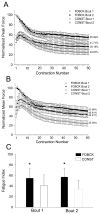Enhancing muscle force and femur compressive loads via feedback-controlled stimulation of paralyzed quadriceps in humans
- PMID: 21272720
- PMCID: PMC3056337
- DOI: 10.1016/j.apmr.2010.10.031
Enhancing muscle force and femur compressive loads via feedback-controlled stimulation of paralyzed quadriceps in humans
Abstract
Objective: To compare paralyzed quadriceps force properties and femur compressive loads in an upright functional task during conventional constant-frequency stimulation and force feedback-modulated stimulation.
Design: Crossover trial.
Setting: Research laboratory.
Participants: Subjects (N=13; 12 men, 1 woman) with motor-complete spinal cord injury.
Interventions: Subjects performed 2 bouts of 60 isometric quadriceps contractions while supported in a standing frame. On separate days, subjects received constant-frequency stimulation at 20Hz (CONST) or frequency-modulated stimulation triggered by a change in force (FDBCK). During FDBCK, a computer algorithm responded to each 10% reduction in force with a 20% increase in stimulation frequency.
Main outcome measures: A biomechanical model was used to derive compressive loads on the femur, with a target starting dose of load equal to 1.5 times body weight.
Results: Peak quadriceps force and fatigue index were higher for FDBCK than CONST (P<.05). Within-train force decline was greater during FDBCK bouts, but mean force remained above CONST values (P<.05). As fatigue developed during repetitive stimulation, FDBCK was superior to CONST for maintenance of femur compressive loads (P<.05).
Conclusions: Feedback-modulated stimulation in electrically activated stance is a viable method to maximize the physiologic performance of paralyzed quadriceps muscle. Compared with CONST, FDBCK yielded compressive loads that were closer to a targeted dose of stress with known osteogenic potential. Optimization of muscle force with FDBCK may be a useful tactic for future training-based antiosteoporosis protocols.
Copyright © 2011 American Congress of Rehabilitation Medicine. Published by Elsevier Inc. All rights reserved.
Figures





Similar articles
-
High dose compressive loads attenuate bone mineral loss in humans with spinal cord injury.Osteoporos Int. 2012 Sep;23(9):2335-46. doi: 10.1007/s00198-011-1879-4. Epub 2011 Dec 21. Osteoporos Int. 2012. PMID: 22187008 Free PMC article.
-
Feedback-controlled stimulation enhances human paralyzed muscle performance.J Appl Physiol (1985). 2006 Nov;101(5):1312-9. doi: 10.1152/japplphysiol.00385.2006. Epub 2006 Jun 29. J Appl Physiol (1985). 2006. PMID: 16809630 Free PMC article. Clinical Trial.
-
Effect of electrical stimulation pattern on the force responses of paralyzed human quadriceps muscles.Muscle Nerve. 2007 Apr;35(4):471-8. doi: 10.1002/mus.20717. Muscle Nerve. 2007. PMID: 17212347
-
The effectiveness of progressively increasing stimulation frequency and intensity to maintain paralyzed muscle force during repetitive activation in persons with spinal cord injury.Arch Phys Med Rehabil. 2008 May;89(5):856-64. doi: 10.1016/j.apmr.2007.10.027. Arch Phys Med Rehabil. 2008. PMID: 18452732 Free PMC article.
-
Muscle and bone plasticity after spinal cord injury: review of adaptations to disuse and to electrical muscle stimulation.J Rehabil Res Dev. 2008;45(2):283-96. doi: 10.1682/jrrd.2007.02.0031. J Rehabil Res Dev. 2008. PMID: 18566946 Free PMC article. Review.
Cited by
-
High dose compressive loads attenuate bone mineral loss in humans with spinal cord injury.Osteoporos Int. 2012 Sep;23(9):2335-46. doi: 10.1007/s00198-011-1879-4. Epub 2011 Dec 21. Osteoporos Int. 2012. PMID: 22187008 Free PMC article.
-
Strategies for Rapid Muscle Fatigue Reduction during FES Exercise in Individuals with Spinal Cord Injury: A Systematic Review.PLoS One. 2016 Feb 9;11(2):e0149024. doi: 10.1371/journal.pone.0149024. eCollection 2016. PLoS One. 2016. PMID: 26859296 Free PMC article.
-
A minimal dose of electrically induced muscle activity regulates distinct gene signaling pathways in humans with spinal cord injury.PLoS One. 2014 Dec 22;9(12):e115791. doi: 10.1371/journal.pone.0115791. eCollection 2014. PLoS One. 2014. PMID: 25531450 Free PMC article.
-
Fatigue modulates synchronous but not asynchronous soleus activation during stimulation of paralyzed muscle.Clin Neurophysiol. 2013 Sep;124(9):1853-60. doi: 10.1016/j.clinph.2013.03.027. Epub 2013 May 11. Clin Neurophysiol. 2013. PMID: 23673062 Free PMC article.
-
Spinal Cord Injury and Osteoporosis: Causes, Mechanisms, and Rehabilitation Strategies.Int J Phys Med Rehabil. 2013;1:127. Int J Phys Med Rehabil. 2013. PMID: 25419534 Free PMC article.
References
-
- Eser P, Frotzler A, Zehnder Y, Wick L, Knecht H, Denoth J, et al. Relationship between the duration of paralysis and bone structure: a pQCT study of spinal cord injured individuals. Bone. 2004;34:869–80. - PubMed
-
- Vestergaard P, Krogh K, Rejnmark L, Mosekilde L. Fracture rates and risk factors for fractures in patients with spinal cord injury. Spinal Cord. 1998;36(11):790–6. - PubMed
Publication types
MeSH terms
Grants and funding
LinkOut - more resources
Full Text Sources
Medical
Research Materials

